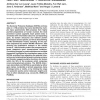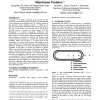59 search results - page 8 / 12 » EVEREST: automatic identification and classification of prot... |
BMCBI
2008
13 years 7 months ago
2008
Background: As the number of non-synonymous single nucleotide polymorphisms (nsSNPs), also known as single amino acid polymorphisms (SAPs), increases rapidly, computational method...
NAR
2007
13 years 7 months ago
2007
Phylogenomic analysis addresses the limitations of function prediction based on annotation transfer, and has been shown to enable the highest accuracy in prediction of protein mol...
NAR
2006
13 years 7 months ago
2006
The Nucleolar Proteome Database (NOPdb) archives data on .700 proteins that were identified by multiple mass spectrometry (MS) analyses from highly purified preparations of human ...
KDD
2003
ACM
14 years 8 months ago
2003
ACM
A number of medically important disease-causing bacteria (collectively called Gram-negative bacteria) are noted for the extra "outer" membrane that surrounds their cell....
ESWA
2006
13 years 7 months ago
2006
Proteomics is a field dedicated to the analysis and identification of proteins within an organism. Within proteomics, two-dimensional electrophoresis (2-DE) is currently unrivalle...



